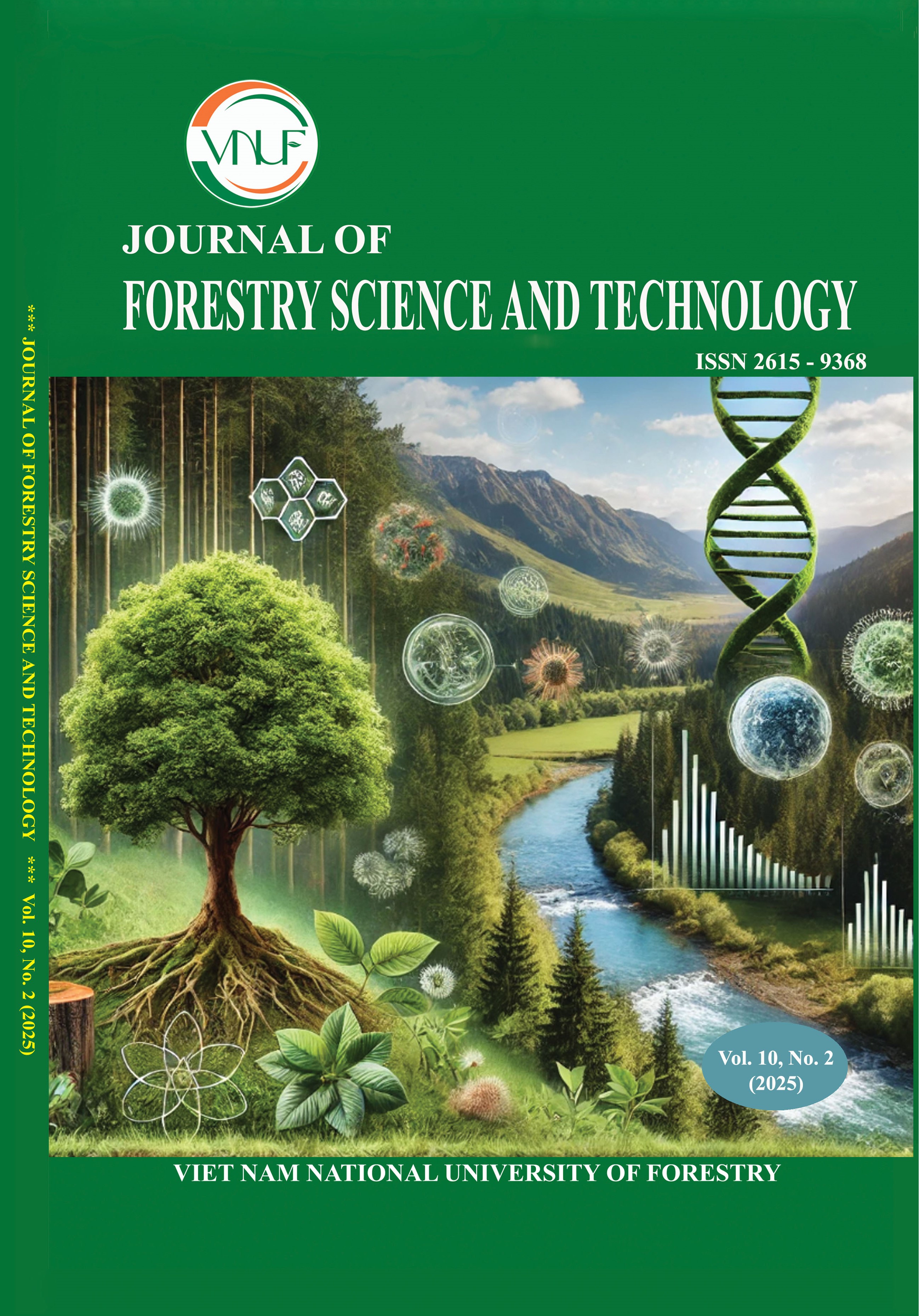Effects of biochar-based organic microbial fertilizer on the growth and yield of Coffee (Coffea canephora) and Pepper (Piper nigrum) in Gia Lai Province
DOI:
https://doi.org/10.55250/Jo.vnuf.10.2.2025.012-021Keywords:
Biochar, black pepper, coffee, Gia Lai, organic microbial fertilizer, sustainable agricultureAbstract
Nghiên cứu này được tiến hành nhằm đánh giá hiệu quả của việc bón phân hữu cơ vi sinh gốc than sinh học, được sản xuất từ phụ phẩm nông nghiệp, trong việc cải thiện sinh trưởng và năng suất cà phê (Coffea canephora) và hồ tiêu đen (Piper nigrum) tại tỉnh Gia Lai. Nghiên cứu sử dụng mô hình ứng dụng thử nghiệm tại bốn xã: Ia Yok và Ia Sao (huyện Ia Grai) cho cà phê, và Ia Bang và Đăk So Mei (huyện Đăk Đoa) cho hồ tiêu đen. Tổng cộng 100 tấn phân bón (25 tấn/xã) đã được cung cấp cho nông dân địa phương và được bón theo một quy trình kỹ thuật chuẩn hóa, với các biện pháp xử lý kiểm soát sử dụng phân bón hóa học thông thường. Kết quả cho thấy việc bón phân hữu cơ vi sinh gốc than sinh học đã làm tăng năng suất cây trồng từ 15,52% đến 15,77% so với đối chứng. Không có dịch bệnh lớn nào xảy ra trong suốt thời gian canh tác. Các sản phẩm thu hoạch từ mô hình cho thấy tính đồng đều cao và cải thiện đáng kể về cả các thành phần năng suất và các chỉ tiêu chất lượng. Những phát hiện này khẳng định tiềm năng của phân bón hữu cơ vi sinh gốc than sinh học trong việc nâng cao hiệu quả sản xuất và chất lượng sản phẩm. Nghiên cứu góp phần thúc đẩy phát triển nông nghiệp bền vững cho cây cà phê và hồ tiêu tại tỉnh Gia Lai và có thể làm mô hình tham khảo cho các vùng khác có điều kiện tương tự.
References
[1]. Dois L. S. S. & Silva J. P. D. (2021). Biochar effects on soil properties and greenhouse gas emissions. The Science of The Total Environment. 7: 221-262. DOI: https://doi.org/10.1016/j.scitotenv.2020.142851.
[2]. Intergovernmental Panel on Climate Change (IPCC) (2019). "Chapter 4: Land Degradation". IPCC Special Report on Climate Change and Land. [Online]. Available: https://www.ipcc.ch/srccl/chapter/chapter-4/.
[3]. N. Thi Thanh Viet, B. Phuong Anh, N. Duc Hanh, L. Minh Huy, N. Thanh Duy, B. The Doi & P. Thi Bich Lieu (2024). Research on building a biochar production model from agricultural by-products in Gia Lai province. Journal of Forestry Science and Technology. 9(2): 003–010. https://doi.org/10.55250/Jo.vnuf.9.2.2024.003-010.
[4]. Ministry of Agriculture and Rural Development (MARD) (2019). National Technical Regulation on Organic Bio-Fertilizers. QCVN 01-189:2019/BNNPTNT. Hanoi, Vietnam.
[5]. Western Highlands Agriculture and Forestry Science Institute (WASI) (n.d.) (2017). Scientific basis for determining the amount of fertilizer for Coffea trees. Retrieved from https://wasi.org.vn/co-so-khoa-hoc-xac-dinh-luong-phan-bon-cho-cay-ca-phe/ on August 10, 2024.
[6]. Western Highlands Agriculture and Forestry Science Institute (WASI) (n.d.) (2019). Fertilizing and plant protection in organic Piper nigrum production. (Retrieved from https://wasi.org.vn/bon-phan-va-bao-ve-thuc-vat-trong-san-xuat-ho-tieu-theo-huong-huu-co/ on August 10, 2024).
[7]. B. Glaser, J. Lehmann & W. Zech (2002). Ameliorating physical and chemical properties of highly weathered soils in the tropics with charcoal – a review. Biol Fertil Soils. 35: 219–230. DOI:10.1007/s00374-002-0466-4.
[8]. Y. J. Kim, J. Y. Jung & U. Mishra (2021). Managing Soil Organic Carbon for Climate Change Mitigation and Food Security. In: Soil Organic Carbon and Feeding the Future. CRC Press, Boca Raton, FL. 25–46.
[9]. Natural Resources Conservation Service U.S. Department of Agriculture (2014). Soil Organic Matter. Retrieved from https://www.nrcs.usda.gov/sites/default/files/2022-10/Soil%20Organic%20Matter.pdf on November 18, 2024.
[10]. M. N. Clifford & K. C. Willson (1987). Coffee: botany, biochemistry and production of beans and beverage (reprinted). Croom Helm, London.
[11]. Ton Nu Tuan Nam (2007). Some technical solutions for the sustainable development of pepper production in the Central Highlands. The 5th Forum on Agricultural Extension and Technology.
[12]. FAO (Food and Agriculture Organization) (2018). Climate Change and Food Security: Risks and Responses.
[13]. IPCC (Intergovernmental Panel on Climate Change) (2021). Climate Change 2021: The Physical Science Basis.









